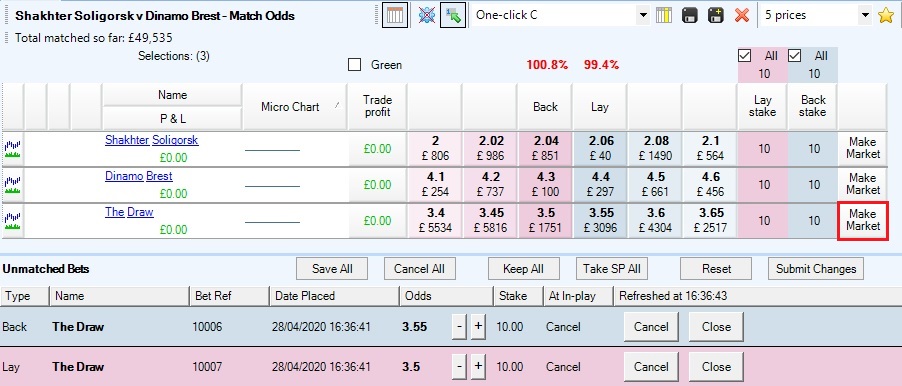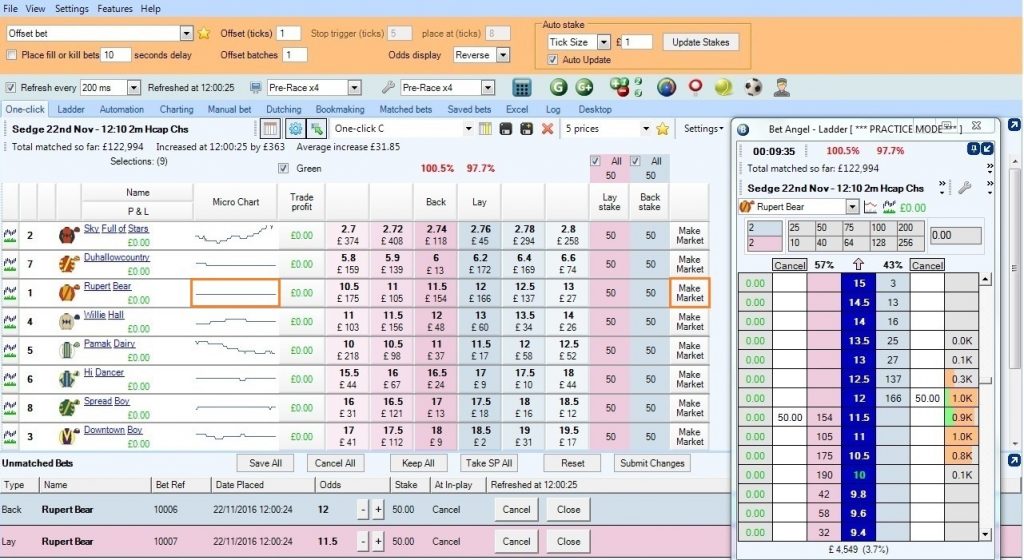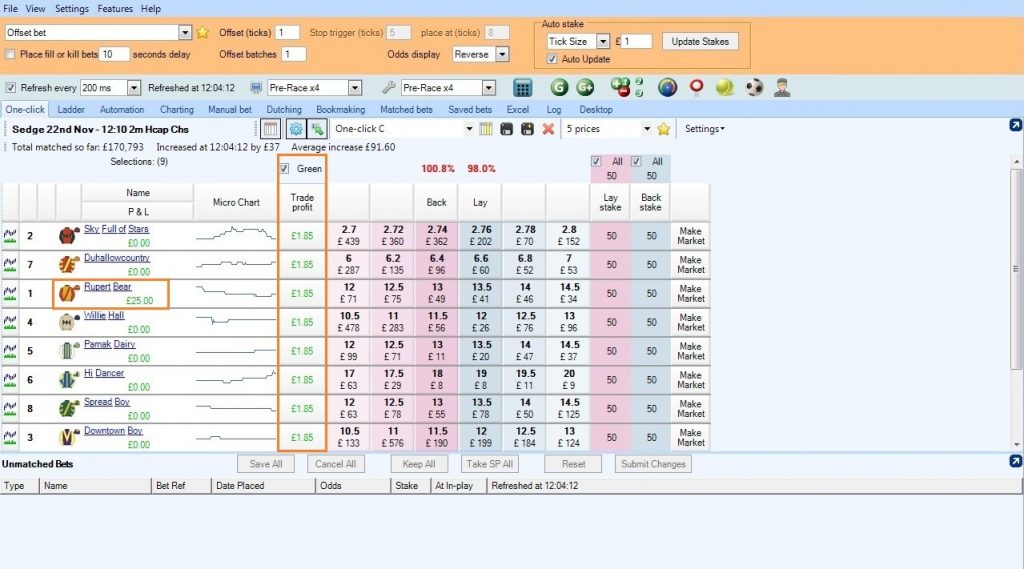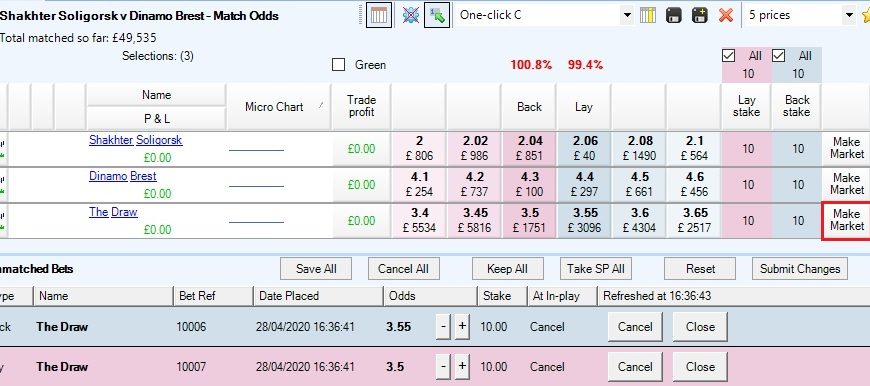The most common Betfair trading technique and one of the first things most people will come across and want to try when beginning their Betfair trading journey is ‘Scalping’. If you’ve landed here without knowing what Scalping have a read of this blog first on Scalping Explained.
What is Scalping?
To quickly summarise what Scalping is, in its most basic form scalping involves backing and laying a selection or runner for small 1 or 2 tick price movements. One of the reasons Scalping is so popular among both new and more experienced traders is because its possible to make profit without even needing to predict the longer-term direction of the odds.
To help put this into practice and demonstrate why you need Betfair Trading Software and specialist tools like those found in Bet Angel the following three-part blog series will explain in detail the following; –
- What is Scalping?
- The Different Methods of Scalping
- What to Look For in different Markets
- How to use the Tools of Bet Angel to Efficiently Scalp any Situation
In this first in part, I’ll be looking at how to identify a selection/runner with a stable price when its the best time to try and scalp a tick profit and what tool you can use in Bet Angel to do this quickly with just one click of your mouse, allowing you to get your back and lay in and out of the market as quickly and as often as possible, hopefully with a profit.
With speed being of the essence when scalping Bet Angel has an arsenal of options and tools available to help you do this quicker and easier. Using some of these tools its possible you can make complete scalping trades (back, lay & cash out) all with just one click of your mouse, push of a key or even fully automate it while not even at your PC, but the automation part is for separate blog, for now I’m looking only at scalping pre-off horse racing and pre-off and half time football markets.
Bet Angel’s Make Market Button
Perhaps the easiest way to begin ‘scalping’ using Bet Angel without even needing to set anything up is with the dedicated ‘Make Market’ button, which is available on the one click grid screen.
You can see in the image below this looks very similar to the Betfair trading grid but with a noticeable difference and that’s the ‘Make Market’ button for each selection on the right of the screen – that one button is all you need to scalp with Bet Angel!

The ‘Make Market’ button will instruct the software to place both a back and lay bet simultaneously at the best reverse prices, in the image above if you clicked the ‘Make Market’ button for the Draw it would place/offer a £10 back bet at 3.55 and a £10 lay bet at 3.50 – if both bets get matched you will have secured a small profit, this can be repeated as many or few times as you wish and on as many different selections as you want.
All you need to do is before clicking the ‘Make Market’ button is decide which selection or runner to scalp – and when to do it to give the highest overall chance of sucsess.
Identifying a selection or runner to scalp
For this first example, I’m looking at scalping a pre-off horse racing market, you could also use this same method and ‘Make Market’ button for scalping football pre-off or during half time as well as many others.
With this method of scalping, you’re ideally looking for a selection or runner whose price is quite steady. By that we mean it’s not one whose odds are drifting or steaming quickly. In the image below of a pre-off horse racing market.
I’ve identified the runner named ‘Rupert Bear’ as just one of a few runners whose odds are currently very steady, this can be seen from its micro chart we highlighted next to its name. The micro chart shows the price movement over the last 30-seconds, as you can see from the chart its hasn’t moved anywhere during the last 30secs at least.
On the right of the screen I’ve placed a ladder for this runner, this is just for illustration purposes so you can see how the bets would appear once the ‘Make Market’ button is clicked. Its also useful in that it’s showing that even over the long term its remained within a solid 4 tick range, this reinforces the fact the price on this runner is very steady and ideal for scalping.
When we say ‘four tick range’ when trading, we are saying that most of the money has been matched between decimal odds of 10.5 and 12. You can see this on the yellow volume bars on the right-hand side of the ladder interface which we have inset on this image.

Once you have identified a runner whose price looks steady the next thing to check for is the amount of unmatched money there is waiting on either side of its current price, as your bets will be queued behind this you’ll be wanting to see a similar amount waiting on both the back and lay side. That way both should near the front of the queue and get matched around the same time. On ‘Rupert Bear’ you can see there is £154 one side and £166 on the other so it’s about as close as you can get.
If both sides had very small amounts of money waiting to be matched that would be even better as you would be instantly near the front of the order queue with both your back and lay bets and should be matched pretty quickly. The worst time to use the ‘Make Market’ button and try and scalp is when there is a much smaller amount of money waiting on one side compared to the other.
If you look at the runner above ‘Dulhallowcounty’ there is £13 on one side and £172 the other, trying to scalp this means your almost certain to have your lay bet at 6.0 matched quickly as there is only £13 in front of you but there’s a good chance that the price will then move down a tick leaving your back bet stuck at 6.2 behind nearly £200 of money waiting to be matched. This will force you to either scratch, get out for a zero profit/loss, or worse; take a 1 tick loss.
So, at this moment in time ‘Rupert Bear’ is in the ideal runner to try and scalp using the ‘Make Market’ button in this pre-off market. As I mentioned above as soon as it’s clicked a back and lay bet will simultaneously be placed and will be shown in the unmatched area at the bottom of your screen. Hopefully, they’ll be matched fairly quickly and when they do they will disappear from the unmatched bets area.
And that’s all there is to it! You can now repeat this process over and over, once the criteria of a steady price and similar amounts of money are waiting on both sides can be seen. If not on the same runner, then any of the others.
When you have finished scalping a market you have the option of leaving any profits on just the runners you have traded on or to ‘Green Up’ (cash out) and spread that equally across all runners so you profit no matter who wins.
Looking at the image below at the moment I can leave things as they are and will make a profit of £25 but only if ‘Rupert Bear’ wins, however, I will lose nothing if any other runner wins. Or with the ‘Green’ box ticked it’s showing me I can ‘Green up’ for an equal profit of £1.87 across all selections no matter which runner wins. To do this I just need to click on any of the figure’s shown in the trade profit column once and the software will do this for me.

Similarly, if you get one bet matched and the price starts to move before the other side is matched you can click the figure in this trade profit column and that will close the trade for you for a small loss or scratch. Then as above you can begin the process again!
Follow the instructions on the article and you should be well on your way to getting your first successful trade through the market.
In parts 2 and 3 of this series of blogs I’ll be detailing other ways of scalping pre-off racing and the pre-off and HT football markets using different tools and options within Bet Angel.


Excellent artical and excellent product very easy to use, keep up the good work
Morning, I am new to Bet Angel and horse racing and have read part one of your Scalping article but unfortunately cannot find a link to parts 2 and 3, plus once masters how to automate this system. Links to the 3 remaining articles would be greatly appreciated. Yours William Scott. ( Sorry to contact you this way but as I continue my introduction I am coming against articles of interest, randomly.)